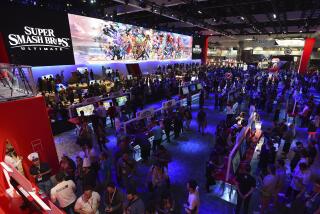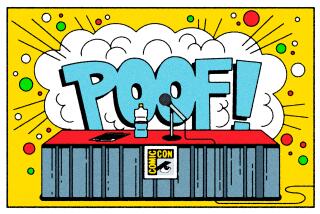Consumer Electronics Show lacks the Next Big Thing
- Share via
As the Consumer Electronics Show kicks off, paper-thin TVs, feather-light laptops and thousands of humming doodads of every hue are filling up more than 30 football fields’ worth of Las Vegas convention space.
But if you’re looking for a device with the potential to instantly change your life, your best bet might be across the street at the slot machines.
The world’s largest personal technology convention, which starts Monday, often sets the tone for the year in gadgetry, attracting the industry’s biggest companies to its glitzy stages to showcase the latest innovations.
The technologies that capture the CES buzz often go on to become top sellers — such as tablet computers last year or high-definition TVs before that.
This year, though, the Next Big Thing remains elusive. Despite what is expected to be a record number of exhibitors and attendees, many analysts agree that no single device or technology has emerged to define the show.
Further dimming CES’ star power: Many of the industry’s best-known firms, including Verizon Wireless, Motorola Mobility and T-Mobile are scaling back their presence, whether opting to skip news conferences or to fold up the opulent booths they’ve had in years past.
Microsoft Corp., long a CES stalwart whose chief executives have delivered the show’s keynote speech for nearly a decade, said in December it would not return to the show after this year, and that it prefers to announce its products on its own schedule.
That is a strategy also espoused by Apple Inc., widely considered the technology industry’s most innovative firm. Apple does not attend CES at all, though its employees can be found prowling the exhibits to check out the competition.
At CES these days, “a lot of brands are not unveiling everything that’s coming out,” said Shannon Jenest, a spokeswoman for audiovisual giant Royal Philips Electronics, which in lieu of a large booth will host a smaller lounge area in the Venetian Hotel, focusing almost exclusively on headphones.
That is in part because modern electronics companies can develop and release products in a matter of months, she said, and some products that will come out in 2012 have yet to be developed.
The show’s organizers expect nearly 2,700 exhibitors and more than 150,000 attendees, the highest since 2006, a surge that reflects renewed consumer spending on gadgets and mobile devices.
But with a dearth of high-profile product announcements, analysts say CES could end up being a sea of familiar looking devices: mainly big-screen TVs, stereo systems and a variety of quirky prototypes and accessories.
“If you really take all the big guys out of there, all you have is a bazaar,” said Roger Kay, an analyst at Endpoint Technologies Associates Inc. who has been going to the show since 2004. “Who’s going to support the show? All those guys with the little neon-pink iPhone cases?”
This year’s show will have no shortage of gizmos, such as SolarFocus Technology’s solar-powered cover/recharger for your electronic book reader. Ace Bayou Corp. has its X-rocker, a leather recliner with built-in speakers that rumbles bass waves through the seated game player. And TOSY Robotics will unveil “a brand new entertainment robot,” apparently to be introduced by tween pop sensation Justin Beiber.
And as for iPhone cases, there will be plenty. The show will feature an 80,000-square-foot area called the iLounge that will feature “all things iPod, iPhone, iPad and beyond.” But you won’t find a single Apple product there.
Indeed, Apple’s absentee influence on the show has been felt for years, as manufacturers have trotted out hordes of Apple-like products, most of which eventually disappear from the marketplace.
Last year, electronics makers showed nearly 100 tablet computers at CES, but the iPad’s dominance remained unchallenged until late last year, when a competing tablet, the Kindle Fire, was released by Amazon.com Inc. (Amazon does not participate in CES either.)
This year, marketers have sought to generate buzz for another Apple-like product. The Ultrabook is a new class of extra-light laptop computer that turns on quickly and runs for a longer period on a single battery charge. Chipmaker Intel Corp. has spearheaded the promotion of the machines, which can cost $900 to $1,400.
But many observers have said that the new devices are once again inspired by existing designs from Apple, which has found a resounding success in its lightweight MacBook Air line of laptops introduced in 2008.
“The real innovation continues to come from Apple,” said analyst Tim Bajarin of Creative Strategies Inc. “It’s unfortunate, but the majority of the vendors out there are just in the place that they have to play catch-up.”
Could there be another potential blockbuster product at CES this year?
“We’re not seeing it,” Bajarin said.
Some analysts have likened the plight of CES to that of Comdex, the main computer industry trade show that went belly up in 2004.
In the 1980s, Comdex made a name for itself when companies announced blockbuster products such as Microsoft Office and Lotus 1-2-3.
But the show later ballooned into an extravaganza featuring thousands of exhibitors competing for attention to hawk a huge array products. The show eventually folded when it lost its cache to smaller, more focused industry events.
In consumer electronics, too, many companies now wait for more specialized industry conferences to announce their major products.
For phone makers, that’s the Mobile World Congress that takes place in Barcelona, Spain, in late February. For game system manufactures, it’s E3, the summertime Electronic Entertainment Expo in Los Angeles.
Smaller shows are not only more manageable for retailers looking for new products to put on their shelves, but less crowded and more affordable for exhibitors showing off their wares.
At CES, the cost of running an exhibition booth can run from $1 million for a modest display to upward of $10 million for companies that rent tens of thousands of square feet and build elaborate showcase structures, said Dave Arland, an industry consultant and former marketing executive at RCA, where he was responsible for the electronics maker’s CES booth.
“By the time you pay for everything — designing the exhibit, shipping all your products, hiring staff, having it up for five or six days — it’s a big commitment,” Arland said.
Much of the remaining draw of CES, conference goers say, comes from the old-fashioned opportunity to see clients face-to-face and to kick the tires on new products.
“We still see value attending CES to gauge the state of the business and look beyond the gloss,” said Lee Greenberg, who runs a marketing research firm in upstate New York and has been going to CES since 1995.
But for many of the companies packing into Las Vegas’ convention center, he said, “the question is whether the juice is worth the squeeze.”
More to Read
Inside the business of entertainment
The Wide Shot brings you news, analysis and insights on everything from streaming wars to production — and what it all means for the future.
You may occasionally receive promotional content from the Los Angeles Times.










